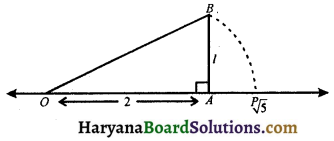Haryana State Board HBSE 9th Class Maths Solutions Chapter 1 Number Systems Ex 1.2 Textbook Exercise Questions and Answers.
Haryana Board 9th Class Maths Solutions Chapter 1 Number Systems Exercise 1.2
Question 1.
State whether the following statements are true or false. Justify your answers.
(i) Every irrational number is a real number.
(ii) Every point on the number line is of the form \(\sqrt{m}\), where m is a natural number.
(iii) Every real number is an irrational number.
Solution :
(i) True, since the collection of rational and irrational numbers is said to be real numbers.
(ii) False, since negative number cannot be square root of any natural number.
(iii) False, since real numbers are the collection of rational and irrational numbers.
![]()
Question 2.
Are the square roots of all positive integers irrational? If not, give an example of the square root of a number that is a rational number.
Solution :
Square root of all positive integers are not irrational number. Since \(\sqrt{16}\) = 4, which is a rational number. Hence, the given statement is wrong.
Question 3.
Show how \(\sqrt{5}\) can be represented on the number line.
Solution :
Draw a number line. Take O as origin. It represents 0. Let OA = 2 units and draw AB ⊥ OA such that AB = 1 unit. Join OB

By Pythagoras theorem,
OB2 = OA2 + AB2
⇒ OB2 = 22 + 12
⇒ OB2 = 4 + 1
⇒ OB2 = 5
⇒ OB = \(\sqrt{5}\) units
with O as centre and OB as radius, draw an arc which cuts the number line at P, then
OP = OB = \(\sqrt{5}\) units.
Thus, P represents \(\sqrt{5}\) on the number line.
![]()
Question 4.
Classroom activity (Constructing the ‘square root spiral’): Take a large sheet of paper and construct the ‘square root spiral’ in the following fashion.

Start with a point O and draw a line segment OP1 of unit length. Draw a line segment P1P2 perpendicular to OP1 of unit length (see figure). Now draw a line segment P2P3 perpendicular to OP2. Then draw a line segment P3P4 perpendicular to OP3. Continuing in this manner, you can get the line segment Pn-1Pn by drawing a line segment of unit length perpendicular to OPn – 1. In this manner, you will have created the points P2, P3 …, Pn, ….. and joined them to create a beautiful spiral depicting \(\sqrt{2}\), \(\sqrt{3}\), \(\sqrt{4}\),…
Solution:
Do as directed.